[English] 日本語
 Yorodumi
Yorodumi- PDB-1fzg: CRYSTAL STRUCTURE OF FRAGMENT D FROM HUMAN FIBRINOGEN WITH THE PE... -
+ Open data
Open data
- Basic information
Basic information
| Entry | Database: PDB / ID: 1fzg | |||||||||
|---|---|---|---|---|---|---|---|---|---|---|
| Title | CRYSTAL STRUCTURE OF FRAGMENT D FROM HUMAN FIBRINOGEN WITH THE PEPTIDE LIGAND GLY-HIS-ARG-PRO-AMIDE | |||||||||
 Components Components | (FIBRINOGEN) x 4 | |||||||||
 Keywords Keywords | BLOOD COAGULATION / PLASMA / PLATELET / FIBRINOGEN / FIBRIN | |||||||||
| Function / homology |  Function and homology information Function and homology informationblood coagulation, common pathway / induction of bacterial agglutination / fibrinogen complex / platelet alpha granule / Regulation of TLR by endogenous ligand / blood coagulation, fibrin clot formation / cellular response to leptin stimulus / MyD88 deficiency (TLR2/4) / positive regulation of heterotypic cell-cell adhesion / IRAK4 deficiency (TLR2/4) ...blood coagulation, common pathway / induction of bacterial agglutination / fibrinogen complex / platelet alpha granule / Regulation of TLR by endogenous ligand / blood coagulation, fibrin clot formation / cellular response to leptin stimulus / MyD88 deficiency (TLR2/4) / positive regulation of heterotypic cell-cell adhesion / IRAK4 deficiency (TLR2/4) / extracellular matrix structural constituent / MyD88:MAL(TIRAP) cascade initiated on plasma membrane / plasminogen activation / p130Cas linkage to MAPK signaling for integrins / positive regulation of peptide hormone secretion / positive regulation of vasoconstriction / GRB2:SOS provides linkage to MAPK signaling for Integrins / protein secretion / positive regulation of exocytosis / protein polymerization / cellular response to interleukin-1 / Integrin cell surface interactions / Common Pathway of Fibrin Clot Formation / negative regulation of endothelial cell apoptotic process / negative regulation of extrinsic apoptotic signaling pathway via death domain receptors / fibrinolysis / cell adhesion molecule binding / Integrin signaling / positive regulation of substrate adhesion-dependent cell spreading / platelet alpha granule lumen / cell-matrix adhesion / positive regulation of protein secretion / Post-translational protein phosphorylation / Signaling by high-kinase activity BRAF mutants / MAP2K and MAPK activation / response to calcium ion / platelet aggregation / Regulation of Insulin-like Growth Factor (IGF) transport and uptake by Insulin-like Growth Factor Binding Proteins (IGFBPs) / Signaling by RAF1 mutants / Signaling by moderate kinase activity BRAF mutants / Paradoxical activation of RAF signaling by kinase inactive BRAF / Signaling downstream of RAS mutants / Signaling by BRAF and RAF1 fusions / Platelet degranulation / extracellular vesicle / protein-folding chaperone binding / : / ER-Phagosome pathway / protein-containing complex assembly / cell cortex / protein-macromolecule adaptor activity / blood microparticle / adaptive immune response / positive regulation of ERK1 and ERK2 cascade / endoplasmic reticulum lumen / Amyloid fiber formation / signaling receptor binding / innate immune response / external side of plasma membrane / synapse / structural molecule activity / cell surface / endoplasmic reticulum / extracellular space / extracellular exosome / extracellular region / metal ion binding / plasma membrane Similarity search - Function | |||||||||
| Biological species |  Homo sapiens (human) Homo sapiens (human) | |||||||||
| Method |  X-RAY DIFFRACTION / X-RAY DIFFRACTION /  SYNCHROTRON / Resolution: 2.5 Å SYNCHROTRON / Resolution: 2.5 Å | |||||||||
 Authors Authors | Everse, S.J. / Spraggon, G. / Veerapandian, L. / Doolittle, R.F. | |||||||||
 Citation Citation |  Journal: Biochemistry / Year: 1999 Journal: Biochemistry / Year: 1999Title: Conformational changes in fragments D and double-D from human fibrin(ogen) upon binding the peptide ligand Gly-His-Arg-Pro-amide. Authors: Everse, S.J. / Spraggon, G. / Veerapandian, L. / Doolittle, R.F. | |||||||||
| History |
|
- Structure visualization
Structure visualization
| Structure viewer | Molecule:  Molmil Molmil Jmol/JSmol Jmol/JSmol |
|---|
- Downloads & links
Downloads & links
- Download
Download
| PDBx/mmCIF format |  1fzg.cif.gz 1fzg.cif.gz | 284.3 KB | Display |  PDBx/mmCIF format PDBx/mmCIF format |
|---|---|---|---|---|
| PDB format |  pdb1fzg.ent.gz pdb1fzg.ent.gz | 223.3 KB | Display |  PDB format PDB format |
| PDBx/mmJSON format |  1fzg.json.gz 1fzg.json.gz | Tree view |  PDBx/mmJSON format PDBx/mmJSON format | |
| Others |  Other downloads Other downloads |
-Validation report
| Arichive directory |  https://data.pdbj.org/pub/pdb/validation_reports/fz/1fzg https://data.pdbj.org/pub/pdb/validation_reports/fz/1fzg ftp://data.pdbj.org/pub/pdb/validation_reports/fz/1fzg ftp://data.pdbj.org/pub/pdb/validation_reports/fz/1fzg | HTTPS FTP |
|---|
-Related structure data
| Related structure data |  1fzeC 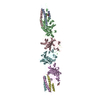 1fzfSC S: Starting model for refinement C: citing same article ( |
|---|---|
| Similar structure data |
- Links
Links
- Assembly
Assembly
| Deposited unit | 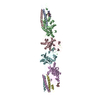
| ||||||||
|---|---|---|---|---|---|---|---|---|---|
| 1 |
| ||||||||
| Unit cell |
| ||||||||
| Noncrystallographic symmetry (NCS) | NCS oper: (Code: given Matrix: (-0.24, 0.965, 0.104), Vector: |
- Components
Components
-Protein , 3 types, 6 molecules ADBECF
| #1: Protein | Mass: 10244.963 Da / Num. of mol.: 2 / Fragment: FRAGMENT DOUBLE-D / Source method: isolated from a natural source / Source: (natural)  Homo sapiens (human) / Organ: BLOOD / Tissue: BLOOD / References: UniProt: P02671 Homo sapiens (human) / Organ: BLOOD / Tissue: BLOOD / References: UniProt: P02671#2: Protein | Mass: 37691.992 Da / Num. of mol.: 2 / Fragment: FRAGMENT DOUBLE-D / Source method: isolated from a natural source / Source: (natural)  Homo sapiens (human) / Organ: BLOOD / Tissue: BLOOD / References: UniProt: P02675 Homo sapiens (human) / Organ: BLOOD / Tissue: BLOOD / References: UniProt: P02675#3: Protein | Mass: 36223.281 Da / Num. of mol.: 2 / Fragment: FRAGMENT DOUBLE-D / Source method: isolated from a natural source / Source: (natural)  Homo sapiens (human) / Organ: BLOOD / Tissue: BLOOD / References: UniProt: P02679 Homo sapiens (human) / Organ: BLOOD / Tissue: BLOOD / References: UniProt: P02679 |
|---|
-Protein/peptide / Sugars , 2 types, 6 molecules STMN
| #4: Protein/peptide | Mass: 467.522 Da / Num. of mol.: 4 / Fragment: FRAGMENT DOUBLE-D / Source method: isolated from a natural source / Source: (natural)  Homo sapiens (human) / Tissue: BLOOD / References: UniProt: P02675*PLUS Homo sapiens (human) / Tissue: BLOOD / References: UniProt: P02675*PLUS#5: Polysaccharide | Source method: isolated from a genetically manipulated source |
|---|
-Non-polymers , 2 types, 115 molecules 


| #6: Chemical | ChemComp-CA / #7: Water | ChemComp-HOH / | |
|---|
-Details
| Compound details | THIS STRUCTURE IS VERY SIMILAR TO ITS FACTOR XIII-CROSSLINKED EQUIVALENT (DOUBLE D) WHEN IT IS CO- ...THIS STRUCTURE IS VERY SIMILAR TO ITS FACTOR XIII-CROSSLINKE |
|---|---|
| Has protein modification | Y |
-Experimental details
-Experiment
| Experiment | Method:  X-RAY DIFFRACTION / Number of used crystals: 1 X-RAY DIFFRACTION / Number of used crystals: 1 |
|---|
- Sample preparation
Sample preparation
| Crystal | Density Matthews: 2.7 Å3/Da / Density % sol: 56.41 % | |||||||||||||||||||||||||||||||||||||||||||||||||
|---|---|---|---|---|---|---|---|---|---|---|---|---|---|---|---|---|---|---|---|---|---|---|---|---|---|---|---|---|---|---|---|---|---|---|---|---|---|---|---|---|---|---|---|---|---|---|---|---|---|---|
| Crystal grow | pH: 7.8 / Details: pH 7.8 | |||||||||||||||||||||||||||||||||||||||||||||||||
| Crystal grow | *PLUS pH: 7 / Method: vapor diffusion, sitting drop | |||||||||||||||||||||||||||||||||||||||||||||||||
| Components of the solutions | *PLUS
|
-Data collection
| Diffraction | Mean temperature: 297 K |
|---|---|
| Diffraction source | Source:  SYNCHROTRON / Site: SYNCHROTRON / Site:  NSLS NSLS  / Beamline: X12C / Wavelength: 1.1 / Beamline: X12C / Wavelength: 1.1 |
| Detector | Detector: CCD / Date: Aug 1, 1998 |
| Radiation | Monochromatic (M) / Laue (L): M / Scattering type: x-ray |
| Radiation wavelength | Wavelength: 1.1 Å / Relative weight: 1 |
| Reflection | Resolution: 2.5→30 Å / Num. obs: 66513 / % possible obs: 96 % / Observed criterion σ(I): 0 / Redundancy: 11.1 % / Rmerge(I) obs: 0.111 |
| Reflection | *PLUS Num. measured all: 737489 |
- Processing
Processing
| Software |
| ||||||||||||||||||||||||||||||||||||||||||||||||||||||||||||
|---|---|---|---|---|---|---|---|---|---|---|---|---|---|---|---|---|---|---|---|---|---|---|---|---|---|---|---|---|---|---|---|---|---|---|---|---|---|---|---|---|---|---|---|---|---|---|---|---|---|---|---|---|---|---|---|---|---|---|---|---|---|
| Refinement | Starting model: 1FZF Resolution: 2.5→30 Å / Data cutoff high absF: 10000000 / Data cutoff low absF: 0.001 / Cross valid method: THROUGHOUT / σ(F): 0
| ||||||||||||||||||||||||||||||||||||||||||||||||||||||||||||
| Displacement parameters | Biso mean: 49.5 Å2 | ||||||||||||||||||||||||||||||||||||||||||||||||||||||||||||
| Refinement step | Cycle: LAST / Resolution: 2.5→30 Å
| ||||||||||||||||||||||||||||||||||||||||||||||||||||||||||||
| Refine LS restraints |
| ||||||||||||||||||||||||||||||||||||||||||||||||||||||||||||
| Software | *PLUS Name:  X-PLOR / Version: 3.843 / Classification: refinement X-PLOR / Version: 3.843 / Classification: refinement | ||||||||||||||||||||||||||||||||||||||||||||||||||||||||||||
| Refinement | *PLUS | ||||||||||||||||||||||||||||||||||||||||||||||||||||||||||||
| Solvent computation | *PLUS | ||||||||||||||||||||||||||||||||||||||||||||||||||||||||||||
| Displacement parameters | *PLUS |
 Movie
Movie Controller
Controller



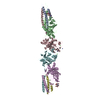

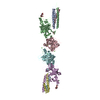


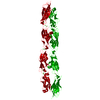



 PDBj
PDBj











